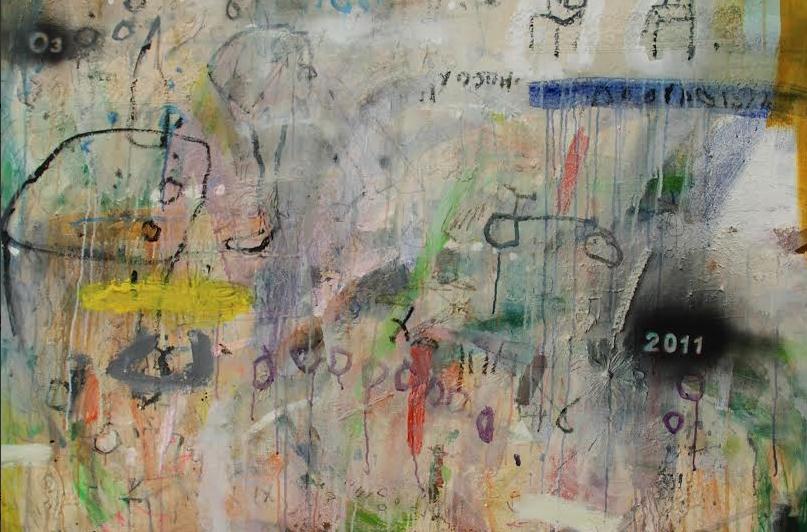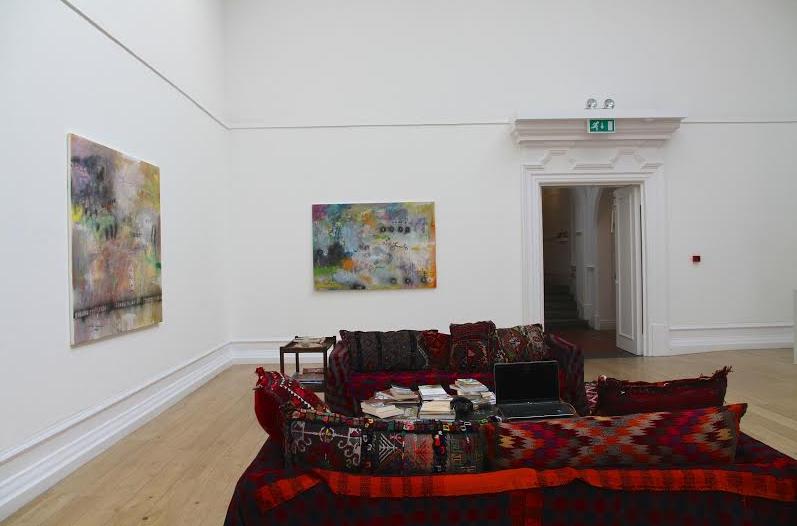[dropcap style=”font-size:100px; color:#992211;”]I[/dropcap] walked into a memorial. A memorial of experiences. And all efforts were made to make me feel comfortable in that space.
South London Gallery was transformed into a living room from a house in the suburbs of Baghdad. There were sofas covered in Iraqi rugs: Indian red and Prussian blue intertwining in order to create the traditional patterns; patterns that correlate with mortality.
The post-war status quo in any nation is as violent as its time of war. More than ten years of post-war stagnation is a form of death, or even worse, pain. The selected artists showcasing their work in the Main Gallery represent this pain. And I could not sit and look at their work. How could I enjoy the comfort of seat when an artist is sharing with me the suffering of an entire nation?
I saw pieces from the embroidery of her torn dress, fragments of his legs stuck on the wall after the car bomb went off, and I saw the number 2011.  Kadhim Nwir’s canvases carry the untold stories of the streets of Basra and Fallujah. Drips, layers, marks, scribbles, and stencils are all part of his abstract alphabet that create an aesthetically appealing chaotic experience. They are a collage of cut-outs of street walls, moments in time, and emotional explosions. His works are aggressive, yet mute. And all that colourful graffiti-like resemblance holds within it neutralised suffering.
Kadhim Nwir’s canvases carry the untold stories of the streets of Basra and Fallujah. Drips, layers, marks, scribbles, and stencils are all part of his abstract alphabet that create an aesthetically appealing chaotic experience. They are a collage of cut-outs of street walls, moments in time, and emotional explosions. His works are aggressive, yet mute. And all that colourful graffiti-like resemblance holds within it neutralised suffering.
“Sustaining some losses is necessary not only as part of the sacrifice and the struggle in the circumstances of the underground change…we should allow for some losses and accept a degree of sacrifice in order that the right and just course may be firmly established, because this is the way of real revolutionaries who believe in the justice of their cause and in their people.”
(from a speech given by Saddam Hussein at the Council of Planning on July 10, 1977).
Sustaining losses continues to this day and since 2003 it has reached 188,000. One hundred and eighty eight thousand human lives.
Stalin said that one death is a tragedy, a million deaths is a statistic. But the tragedy then becomes our indifference to that statistic. It resembles the numbness that follows intense pain. Is her name Leyla? That young girl dressed in a red night shirt, waiting by the side of her bed?
She holds a picture of Saddam against her face. Is that her father standing by the shattered window? He too holds a picture of Saddam against his face. So do those teenage boys and the man from the butcher shop. So does every one in every portrait taken by Jamal Penjweny.
Saddam Hussein is everywhere, in every wounded family and broken home. The aftermath of his regime and downfall still holds on to the country like a chronic illness. Penjweny’s photographic series not only portrays the sacrifice and loss of a nation, but also how justice becomes a luxury; a forever broken promise.
As I walked out of the gallery space I realised why the installation was set up to feel homely and intimate. It emphasises the blurred lines between domestic and violent; safety and tragedy; war and peace. I felt the endeavour to create a sense of security was nothing more than a prop; an intentional illusion. Whether through the time of Saddam’s leadership, his collapse, or the establishment of the current government, the attempts made to create safety and security for the Iraqi home have been staged. Just like the space in South London Gallery, they represent the crippled reality of political impotence.
“Everyday, Beirut kills one of us.
Everywhere, there is death,
In the cup of coffee,
In the door key,
In the terrace flowers,
In the papers,
In the alphabet.
Here we are, Balqis
Back again in Jahiliyyah
Back to savagery.
To backwardness, hideousness and meanness.
Back again to barbarism.
Where writing is a journey
Between fragments.
Where killing a butterfly in its field
Is the case.
Do you know my beloved Balqis?”
Do you know his beloved Balqis?
“The colour of violet in her eyes, twinkles all the time”.
Syrian poet Nizar Qabbani, wrote this poem to lament the death of his wife Balqis and also marking the Palestinian defeat of 1967. Yet every phrase in that writing resonates in today’s Iraq, today’s Syria, today’s Egypt, today’s Palestine, and today’s Lebanon.
Welcome to Iraq, you are still alive.
Welcome to Iraq is showing at South London Gallery until June 1st
[button link=”http://www.southlondongallery.org/page/welcome-to-iraq” newwindow=”yes”] Exhibition Webpage[/button]
Faten Hakimi, Artist and Fine Art Consultant, MA Fine Art City & Guilds www.fatenhakimi.com





















